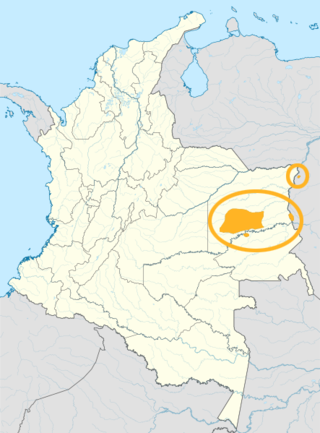Top Qs
Timeline
Chat
Perspective
Piapoco language
Endangered Arawakan language of South America From Wikipedia, the free encyclopedia
Remove ads
Piapoco is an Arawakan language of Colombia and Venezuela.
A "Ponares" language is inferred from surnames, and may have been Piapoco or Achagua.
Remove ads
History
Piapoco is a branch of the Arawak language, which also includes Achagua and Tariana.[2] Piapoco is considered a Northern Arawak language.[3] There are only about 3,000 Piapoco speakers left today. These people live in the Meta, Vichada, and Guaviare rivers in Colombia[4] Piapoco speakers also reside in Venezuela.[5] It is an endangered language.[5]
Geography/Background
The Piapocos come from the larger tribe, the Piaroa, who are indigenous to the Amazon rain forest.[6] The Piapoco people originally lived in the midsection of Rio Guaviare, later moving in the 18th century to avoid settlers, missionaries, and others.[7]
Remove ads
Bilingualism
The word Piapoco is a Spanish nickname in reference to the toucan.[4] Most Piapoco speakers also speak Spanish.[7] Speakers who have had less contact with Spanish speakers more often pronounce the phoneme "s" as a voiceless interdental fricative.[8] Younger speakers of the Piapoco language tend to eliminate the "h" more than older speakers due to their contact with the Spanish language.[8]
When a large portion of people come in contact with another language and are competent in it, their language gradually becomes more like the other.[9] This allows for a gradual convergence, where grammar and semantics of one language begin to replicate the other.[9]
Remove ads
Phonology
Consonants
Vowels
Vowels can be nasalized [ã] when occurring before nasal consonants.[10]
Grammar
A Piapoco-Spanish dictionary containing 2,500 words was written by Deloris Klumpp, in which botanical identification of plants were captured, although not all.[3] The Piapoco language follows the following grammatical rules: plural suffix -nai used for animates only, derivational suffixes masculine -iri, feminine -tua, suffix -mi 'late, defunct,' nominalizing -si, declarative mood marker -ka.[3] Piapoco is unique in that it seems to be a nominative-accusative language.[3] There are eighteen segmental phonemes, fourteen consonant and four vowels in the Piapoco language.[8]
Remove ads
References
Wikiwand - on
Seamless Wikipedia browsing. On steroids.
Remove ads

